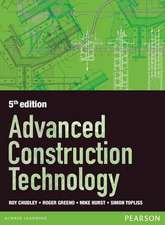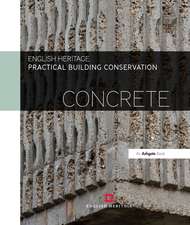Recent Progress in Steel and Composite Structures: Proceedings of the XIII International Conference on Metal Structures (ICMS2016, Zielona Góra, Poland, 15-17 June 2016)
Editat de Marian A. Gizejowski, Jakub Marcinowski, Aleksander Kozlowski, Jerzy Ziółkoen Limba Engleză Hardback – 3 mai 2016
In addition to the five keynote papers the book contains 62 two-page extended abstracts of individual contributions delivered by 164 Authors and Co-authors from 13 countries of four continents. The CD containing all full-length papers is an attachment to the conference book.
Recent Progress in Steel and Composite Structures is a useful reference source to academics, researchers, graduate students and practicing engineers.
Preț: 1211.20 lei
Preț vechi: 1668.96 lei
-27% Nou
Puncte Express: 1817
Preț estimativ în valută:
231.78€ • 243.71$ • 191.50£
231.78€ • 243.71$ • 191.50£
Carte tipărită la comandă
Livrare economică 17 aprilie-01 mai
Preluare comenzi: 021 569.72.76
Specificații
ISBN-13: 9781138029460
ISBN-10: 1138029467
Pagini: 224
Dimensiuni: 174 x 246 mm
Greutate: 0.54 kg
Ediția:1
Editura: CRC Press
Colecția CRC Press
ISBN-10: 1138029467
Pagini: 224
Dimensiuni: 174 x 246 mm
Greutate: 0.54 kg
Ediția:1
Editura: CRC Press
Colecția CRC Press
Public țintă
Postgraduate and ProfessionalCuprins
Keynote papers Advances in understanding shell buckling phenomena and their characterisation for practical design; Advances in seismic assessment of steel-concrete composite high-rise buildings and engineering practices; Harmonization of structural standards on the reliability basis of design; Recent steel structures in Poland - the selected projects; Land-based supporting structures for wind convertors; Cold-formed sections and profiled sheeting Shear strength of trapezoidal and sinusoidal corrugated steel webs; Curved cold formed steel roofing: numerical and experimental analysis; Flexural elastic buckling stress of light gauge built-up member; FEM model of the steel building roof includes stressed skin diaphragm action effects; Experimental investigation of the stabilization of the C-section purlins by sandwich panels; Innovative cold-formed GEB section under compression; Steel-concrete composite structures Concrete confinement estimation in composite steel-concrete columns; AAEM method against Volterra integral analysis of composite beam; Tests of shear connectors used in aluminium-concrete composite structures; Innovative solution of transition zone in steel-concrete hybrid beam; Composite structural electronic transmission tower; Prestressing of simply supported composite bridges: a cost-benefit analysis; Buckling and effect of bracings Diagonal bracing members of lattice towers - analytical versus experimental studies; A unified resistance verification of beam-columns not susceptible to LT-buckling; Lateral-torsional buckling of steel beams with simultaneously tapered flanges and web; Global geometrical imperfections for refined analysis of lateral roof bracing systems; A new method of buckling resistance evaluation of laterally restrained beam-columns; Distortional lateral torsional buckling of open and closed steel cross-sections; Dynamics, fatigue and seismic analyses Experimental and numerical study on polymer element used for reduction of temporary steel grandstand vibrations; The effect of steel properties on deformation capacity of HSS columns; Shakedown seismic analysis of composite steel-concrete frames systems; Comparison between behavior of steel and composite eccentrically braced frames with long links; Collapse behaviour of steel box columns under seismic effect of the combined earthquakes; Determination reserve of bearing capacity for steel, with influence of long-term fatigue load, used in structures in case of a fire; Bridges Atmospheric corrosion tests on weathering steel bridges in the Czech Republic; The history of the first orthotropic bridge in Bulgaria; Finite element analysis of metal-soil bridge under static loads; Effect of endogenous deformations in composite bridges; Quality of butt welds in bridges and fatigue classes according to European Codes and testing; Fatigue of structural elements in steel bridges - theory and practice; Structural steel, metallurgy and behaviour in fire Redistribution of internal forces generated in a steel frame structure with flexible joints when exposed to a fire; Fire resistance evaluation of a steel sway frame load-bearing structure using the linear programming; Recent developments in heavy plate production for modern steel bridges; Modelling for the effect of welding process on buckling of built-up high strength steel box column; Application of Barkhausen method to determine internal stresses in cold-rolled and hot-rolled sheets; Application of Barkhausen effect in the impact assessment of welding to internal stress distribution in steel; Strength, stability and postbuckling behaviour Experimental investigations on non-uniform torsion of the two-chord members laced at a single plane; Computer FVM-FEM analysis of the large span grid shell roof; Buckling strength of a steel multi-storey framework according to Eurocode's general method; Shakedown optimization of the thin-wall metal structures under strength and stiffness constrains; Buckling capacity curves for pressurized spherical shells; An integrated approach for fatigue prevention in Movable Scaffolding System; Stability of a truss under upward wind loading; Preliminary experimental research on stability of truss' joint with positive eccentricity; Joints and connections Durability assessment of connections between sandwich panels and purlins; FEM analysis of the extended end-plate splice of welded I-girders with multiple bolt rows and bolts per row; Equivalent model of semi-rigid supporting node in the calculations of steel frames; Component-based modelling of beam-to-column joints subjected to variable actions; Steel column-base solutions for over-roofing of existing buildings. A numerical study; Numerical analysis of stainless steel bolted lap joints; FEM based assessment of the rotation capacity of bolted joints; Truss design with one-membered elements and N-joints; Silos, tanks and vessels Experimental investigations on the resistance of vertical stiffeners of steel silos shells made of corrugated sheets; Load-bearing capacity of discretely supported steel silos shells with skirts; Postbucklingbehaviour of open thin-walled shells made of stainless steel; Simplified stability analysis of steel cylindrical silos with corrugated walls and vertical columns; Problems of designing tubular shell galleries; Reliability, masts and towers Searching for significant basic variables of experimentally tested steel, cylindrical shells; Reliability level of the buried main pipelines linear part; Influence of bearing capacity and reliability of connections and nodes on bearing capacity and reliability of complex bar structures;Deformation of steel lattice towers for overhead lines - Case study; Influence of the initial guy forces on the static computations of mast taking into account the mast shaft buckling form
Notă biografică
Marian Gizejowski is full professor at the Faculty of Civil Engineering of the Warsaw University of Technology in Poland. His research and lecturing experience includes the position of Postdoctoral Fellow at the University of Sydney in 1983, the Senior Lecturer position at the University of Zimbabwe 1988-1994 and the Associate Professor position at the University of Botswana 2001-2005. He has been invited to become the member of Advisory Boards and Scientific Committees of several international conferences, and to prepare plenary keynote lectures at the conferences taken place worldwide. He has been the author or co-author of several books as well as over 300 journal and conference papers. His research interest is focused on different aspects of structural stability, resistance assessment and codification, as well as on nonlinear analysis and design of steel and aluminum structures. Recently, he has especially focussed on furthering progress in the formulation of stability verification procedures for the application in Eurocodes and the unification of resistance partial factors for their application in different design situations. Jakub Marcinowski is a research professor at Faculty of Civil Engineering, Architecture and Environmental Engineering in University of Zielona Gora, Poland. He obtained his academic degrees at the Technical University of Wroclaw where he was graduated from Faculty of Civil Engineering. He used to work in Iraq at Mosul University (1988/1989) and at Saddam University for Engineering and Science (1989/1990) as an Assistant Professor. The main field of his scientific activity is structural stability phenomena and shell buckling. He is an author or co-author of more than 200 journal and conference papers and other publications. Since 2008 he is a member of Task Working Group TWG8.4 (stability of shells), acting within the European Convention for Constructional Steelwork, ECCS. He is also a member of three Working Groups of European Committee for Standardization acting on amendments to existing European standards. Aleksander Kozlowski is a full professor in Civil Engineering in Rzeszow University of Technology, Poland. He is currently a Head of Department of Building Structures at this University. He previously worked as a visiting professor in Univesidade da Beira Interior, Covilha, Portugal. He has been invited to become the member of Advisory Boards and Scientific Committees of several international conferences, such as Eurosteel, and took part in few European Projects, such as Cost, Robust, Android, Affordable House and Purest. He has been the author or co-author of over 200 journal and conference papers and several technical books. His recent investigations focus on steel and composite joints and their influence on structure behavior. Jerzy Ziolko is emeritus professor of the Faculty of Civil Engineering and Environment of the Gdansk University of Technology. He was granted the honorable distinction of the Doctor of Honoris Causa in 2012 by the University of Technology and Life Sciences in Bydgoszcz, Poland. Professional and research interests of Professor Jerzy Ziolko focus on different structural and technological aspects of metal building and civil engineering structures, mostly steel shell structures (tanks for liquids and gases), durability and safety of steel structures, rheological aspects of mechanical properties of steel due to long-lasting exploitation and methods of modern assembly, maintenance and restoration of steel structures. Professor Ziolko has published 14 books (including 4 authored individually) and 213 chapters and journal articles (including 39 in foreign journals). He is a member of Editorial Board of the journal Steel Construction - Design and Research. He has been invited to become the member of Advisory Boards and Scientific Committees of several international conferences, and to prepare plenary keynote lectures at the conferences taken place worldwide.
Descriere
Containing contributions that focus on the progress made in theoretical, numerical and experimental research, Recent Progress in Steel and Composite Structures is a useful reference source to academics, researchers, graduate students and practicing engineers.


